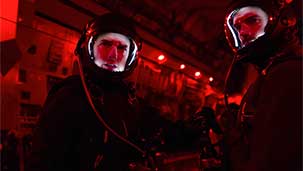You’ve reached the top of a very contemporary food chain. Behind-the-scenes features have been a standard part of filmmaking since DVD extras became a compulsory part of blockbuster movie packaging. They stopped being an afterthought almost two decades ago, but never truly lead the advertising campaign until the recent incarnations of the Mission: Impossible series. For these movies, your contribution is as important as any trailer, poster, or casting news. And once again, your work sets up and sells the movie perfectly.
The formula for what makes a Mission: Impossible movie work is easy to confuse with the Bond formula - at least three major action set pieces (beginning, middle and end), exotic global destinations, and death-defying stunts that make the audience gasp. But unlike Bond, which has a long history of interchanging its lead and no trouble subbing in stuntmen to do the dirty work, Mission:Impossible is a Tom Cruise vehicle through-and-through. It’s an outlet for him to try something insane, film it, and put it into a movie. Your responsibility is to carry that unique narrative forward, and create continuity between the actuality of a stunt and the artificiality of making a movie.
In the case of Fallout, the sixth mission, your videos focus on two stunts in particular. The first is the HALO jump (High Altitude, Low Open) - where Cruise free-falls from over 25,000 feet and then deploys his chute at 2,000 feet. Whether or not he accomplished the LO part of the jump is less relevant than the opening of the sequence, which begins as a seamless take of jumping out of the sky and chasing another jumper, including glorious close-ups and wild mid-air maneuvering. It the kind of moment that’s breathtaking, but also hard to accept as a viewer after we’ve seen so much superhero trickery on screen of late. But knowing the series credo to make the action as authentic as possible puts the audience on the filmmaker’s side to at least give these moments the benefit of the doubt and suspend our disbelief.
The second, and probably least appreciated gonzo commitment from Cruise, was learning how to stunt fly a helicopter through mountainous terrain (and to be pulled up underneath a helicopter as it’s taking off). Again, the technique is done in a way that feels almost too good to be true, but also mixed with enough other unbelievable action that part of our brain turns off and assumes they just found a way to fake it.
Unless, of course, we’ve seen your videos. Even the ones when the stunts don’t work and Cruise breaks his ankle (ouch!).
For someone as spoiler-phobic as me, I save all trailers and BTS (behind-the-scenes) features until after I see the film. Which means part of the joy of walking out of Fallout was immediately flipping open my laptop and parsing through what was actually done as practical effects. None of that matters if the movie doesn’t move me, but Fallout did get my blood going by the second half (it has a strangely sleepy start, but once it kicks into high gear - look out). In fact, it wasn’t a particularly stunt-heavy sequence that locked me into the film, but the single take of kidnapping a prisoner, which ends in what seems to be a shocking decision for Cruise’s Ethan Hunt character. Something emotional honesty is more important than filming reality, but when you can accomplish both in a movie this big - that’s the kind of impossible mission few other films seem to be able to pull off.
Sincerely,

Christopher







